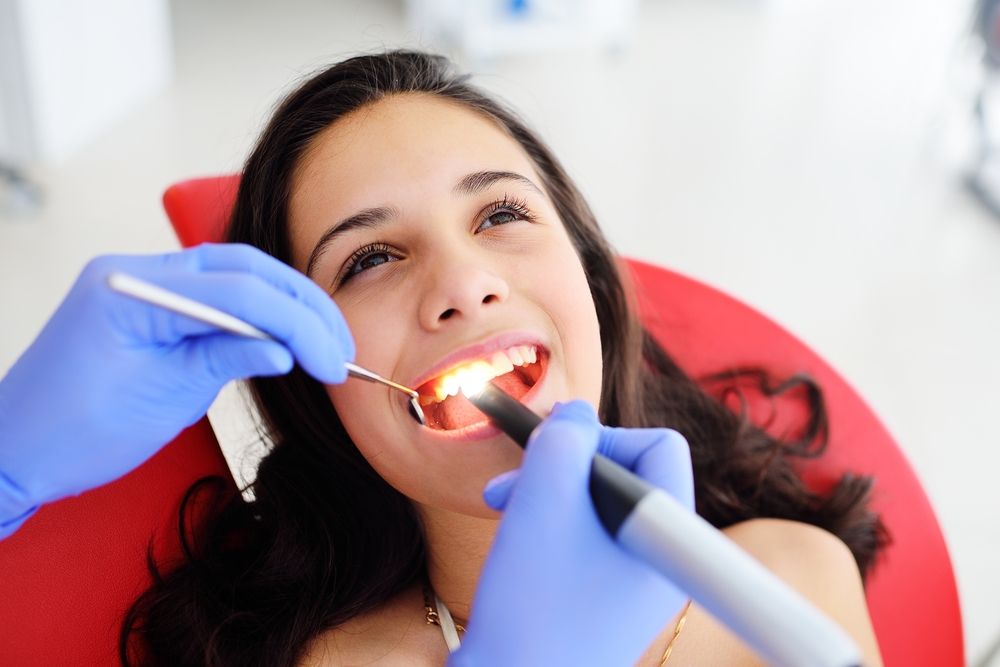Dental prophylaxis is a cleaning procedure performed by a dental hygienist to thoroughly clean the teeth. Prophylaxis helps stop the progression of periodontal disease and gingivitis in order to reach a maintenance care level of daily oral hygiene.
Preventing Gingivitis with Prophylaxis
Gingivitis, periodontal disease, and pericoronitis occur when bacteria from plaque aren’t cleaned from the teeth and gums completely on a regular basis and have the time to grow and harden. Gum disease becomes a problem because bacteria reach between the gums and the teeth and cause further damage including gum recession and gum loss. It also causes terribly bad breath.
These bacterial colonies cause inflammation and irritation which can create a systemic chronic inflammatory response throughout your body and lead to further severe health issues. As a result, the body begins to systematically destroy gum and bone tissue, making the teeth shift, become unstable, or completely fall out. The pockets between the gums and teeth become deeper and house more bacteria which may travel via the bloodstream and infect other parts of the body.

Reasons for prophylaxis/teeth cleaning
Prophylaxis cleanings are an effective method of cleaning teeth in order keep the oral cavity in good health and also halt the progression of gum disease.
Here are some of the benefits of prophylaxis:
- Tartar removal – Tartar (calculus) and plaque buildup, both above and below the gum line, can cause serious periodontal problems if left untreated. Even using the best brushing and flossing homecare techniques, it can be impossible to remove debris, bacteria and deposits from gum pockets. The experienced eye of a dentist using specialized dental equipment is needed in order to spot and treat problems such as tartar and plaque buildup.
- Aesthetics – It’s hard to feel confident about a smile marred by yellowing, stained teeth. Prophylaxis can rid the teeth of unsightly stains and return the smile to its former glory.
- Fresher breath – Periodontal disease is often signified by persistent bad breath (halitosis). Bad breath is generally caused by a combination of rotting food particles below the gum line, possible gangrene stemming from gum infection, and periodontal problems. The removal of plaque, calculus and bacteria noticeably improves breath and alleviates irritation.
- Identification of health issues – Many health problems first present themselves to the dentist. Since prophylaxis involves a thorough examination of the entire oral cavity, the dentist is able to screen for oral cancer, evaluate the risk of periodontitis and often spot signs of medical problems like diabetes and kidney problems. Recommendations can also be provided for altering the home care regimen.
What does prophylaxis treatment involve?
Prophylaxis can either be performed in the course of a regular dental visit or, if necessary, under general anesthetic. The latter is particularly common where severe periodontal disease is suspected or has been diagnosed by the dentist. An endotracheal tube is sometimes placed in the throat to protect the lungs from harmful bacteria which will be removed from the mouth.
Prophylaxis is generally performed in several stages:
- Supragingival cleaning – The dentist will thoroughly clean the area above the gum line with scaling tools to rid them of plaque and calculus.
- Subgingival cleaning – This is the most important step for patients with periodontal disease because the dentist is able to remove calculus from the gum pockets and beneath the gum line.
- Root planing – This is the smoothing of the tooth root by the dentist to eliminate any remaining bacteria. These bacteria are extremely dangerous to periodontitis sufferers, so eliminating them is one of the top priorities of the dentist.
- Medication – Following scaling and root planing, an antibiotic or antimicrobial cream is often placed in the gum pockets. These creams promote fast and healthy healing in the pockets and help ease discomfort.
- X-ray and examination – Routine X-rays can be extremely revealing when it comes to periodontal disease. X-rays show the extent of bone and gum recession, and also aid the dentist in identifying areas which may need future attention.
Prophylaxis dental cleanings are recommended twice annually as a preventative measure, but should be performed every 3-4 months on periodontitis sufferers and those with chronic diseases that affect oral health and plaque buildup. Though gum disease cannot be completely reversed, prophylaxis is one of the tools the dentist can use to effectively halt its destructive progress.



